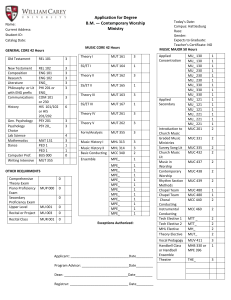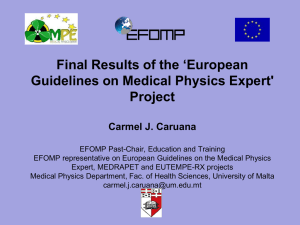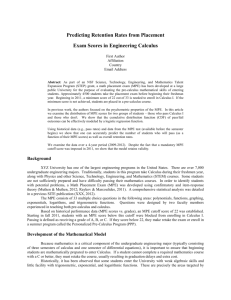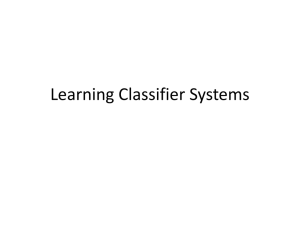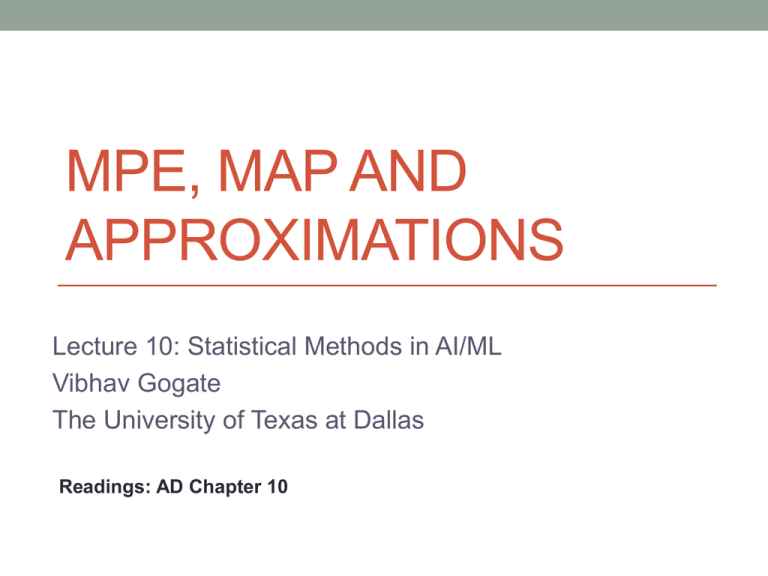
MPE, MAP AND
APPROXIMATIONS
Lecture 10: Statistical Methods in AI/ML
Vibhav Gogate
The University of Texas at Dallas
Readings: AD Chapter 10
What we will cover?
• MPE= most probable explanation
• The tuple with the highest probability in the joint distribution Pr(X|e)
• MAP=maximum a posteriori
• Given a subset of variables Y, the tuple with the highest probability
in the distribution P(Y|e)
• Exact Algorithms
• Variable elimination
• DFS search
• Branch and Bound Search
• Approximations
• Upper bounds
• Local search
Running Example: Cheating in UTD CS
Population
Sex (S), Cheating (C), Tests (T1 and T2) and Agreement (A)
Most likely instantiations
• A person takes a test and the test administrator says
• The two tests agree (A = true)
• What is the most likely group that the individual belongs
to?
• Query: Most likely instantiation of Sex and Cheating given
evidence A = true
• Is this a MAP or an MPE problem?
• Answer: Sex=male and Cheating=no.
MPE is a special case of MAP
• Most likely instantiation of all variables given A=yes
• S=female, C=no, T1=negative and T2=negative
• MPE projected on to the MAP variables does not yield the
correct answer.
• S=female, C=no is incorrect!
• S=male, C=no is correct!
• We will distinguish between
• MPE and MAP probabilities
• MPE and MAP instantiations
Bucket Elimination for MPE
• Same schematic algorithm as before
• Replace “elimination operator” by “maximization operator”
S
male
male
𝑀𝐴𝑋𝑆 female
female
C
yes
Value
0.05
no
yes
no
0.95
0.01
0.99
=
C
yes
no
Value
Collect all instantiations that agree on all other variables
except S
Compute the maximum value
Bucket Elimination for MPE
• Same schematic algorithm as before
• Replace “elimination operator” by “maximization operator”
S
male
male
𝑀𝐴𝑋𝑆 female
female
C
yes
Value
0.05
no
yes
no
0.95
0.01
0.99
=
C
yes
no
Value
0.05
0.99
Collect all instantiations that agree on all other variables
except S and return the maximum value among them.
Bucket elimination: order (S, C, T1, T2)
S
𝐹𝑎𝑐𝑡𝑜𝑟𝑠: ϕ(S)
ϕ(C, S)
ϕ(C, S, T2)
ϕ(C, T1)
ϕ(T1, T2)
Evidence: A=true
𝜓 𝐶, 𝑇2
𝑀𝐴𝑋𝑆
ϕ S ϕ(C, S)ϕ(C, S, T2)
C
𝜓 𝑇1, 𝑇2
𝑀𝐴𝑋𝐶
ϕ(C, T1) 𝜓 𝐶, 𝑇2
T1
𝜓 𝑇2
𝑀𝐴𝑋𝑇1
ϕ(T1, T2) 𝜓 𝑇1, 𝑇2
T2
𝑀𝐴𝑋𝑇2
MPE probability
𝜓 𝑇2
Bucket elimination: Recovering MPE tuple
S
C
𝐹𝑎𝑐𝑡𝑜𝑟𝑠: ϕ(S)
ϕ(C, S)
ϕ(C, S, T2)
ϕ(C, T1)
ϕ(T1, T2)
Evidence: A=true
T1
T2
𝑆𝑒𝑡 𝑇2 = −𝑣𝑒, 𝐶 = 𝑛𝑜
max 𝑆 𝑡𝑢𝑝𝑙𝑒 =?
𝑆 = 𝑓𝑒𝑚𝑎𝑙𝑒
ϕ S ϕ(C, S)ϕ(C, S, T2)
𝑆𝑒𝑡 𝑇2 = −𝑣𝑒, 𝑇1 = −𝑣𝑒
max 𝐶 𝑡𝑢𝑝𝑙𝑒 =?
𝐶 = 𝑛𝑜
ϕ(C, T1) 𝜓 𝐶, 𝑇2
𝑆𝑒𝑡 𝑇2 = −𝑣𝑒
max 𝑇1 𝑡𝑢𝑝𝑙𝑒 =?
𝑇1 = −𝑣𝑒
ϕ(T1, T2) 𝜓 𝑇1, 𝑇2
max 𝑇2 𝑡𝑢𝑝𝑙𝑒 =?
𝑇2 = −𝑣𝑒
MPE probability
𝜓 𝑇2
Bucket elimination: MPE vs PE (Z)
• Maximization vs summation
• Complexity: Same
• Time and Space exponential in the width (w) of the given order:
O(n exp(w*+1))
BE and Hidden Markov models
• BE_MPE in the order S1, S2, S3, ...., is equivalent to the
Viterbi algorithm
• BE_PE in the order in the order S1, S2, S3, ...., is
equivalent to the Forward algorithm
OR search for MPE
• At leaf nodes compute probabilities by taking product of
factors
• Select the path with the highest leaf probability
Branch and Bound Search
• Oracle gives you an upper bound on MPE
• Prune nodes which have smaller upper bound than the current
MPE solution
16
Mini-Bucket Approximation: Idea
Split a bucket into mini-buckets => bound complexity
bucket (Y) =
{ 𝝓1, …, 𝝓r, 𝝓r+1, …, 𝝓n }
𝑛
𝑔 = 𝑀𝐴𝑋𝑌
𝜙𝑖
𝑖=1
{𝝓1, …, 𝝓r }
{𝝓r+1, …, 𝝓n }
𝑟
𝑛
h1 = 𝑀𝐴𝑋𝑌
𝜙𝑖
h2 = 𝑀𝐴𝑋𝑌
𝑖=1
𝑔 ≤ h1 × h2
𝜙𝑖
𝑖=𝑟+1
Mini Bucket elimination: (max-size=3 vars)
C
S
T1
𝐹𝑎𝑐𝑡𝑜𝑟𝑠: ϕ(S)
ϕ(C, S)
ϕ(C, S, T2)
ϕ(C, T1)
ϕ(T1, T2)
Evidence: A=true
T2
𝜓 𝑆, 𝑇1 , 𝜓 𝑆, 𝑇2 𝑀𝐴𝑋𝐶 ϕ S ϕ C, S ϕ C, T1
𝜓 𝑇1, 𝑇2 𝑀𝐴𝑋𝑆
𝜓 𝑇2
ϕ C, S, T2
𝜓 𝑆, 𝑇1 , 𝜓 𝑆, 𝑇2
𝑀𝐴𝑋𝑇1
𝑀𝐴𝑋𝑇2
ϕ(T1, T2)
𝜓 𝑇2
Upper bound on the MPE probability
𝜓 𝑇1, 𝑇2
Mini-bucket (i-bounds)
• A parameter “i” which controls the size of (number of
variables in) each mini-bucket
• Algorithm exponential in “i” : O(n exp(i))
• Example
• i=2, quadratic
• i=3, cubed
• etc
• Higher the i-bound, better the upper bound
• In practice, can use i-bounds as high as 22-25.
Branch and Bound Search
• Oracle = MBE (i) at each point.
• Prune nodes which have smaller upper bound than the current
MPE solution
Computing MAP probabilities: Bucket
Elimination
• Given MAP variables “M”
• Can compute the MAP probability using bucket
elimination by first summing out all non-MAP variables,
and then maximizing out MAP variables.
• By summing out non-MAP variables we are effectively
computing the joint marginal Pr(M, e) in factored form.
• By maximizing out MAP variables M, we are effectively
solving an MPE problem over the resulting marginal.
• The variable order used in BE_MAP is constrained as it
requires MAP variables M to appear last in the order.
MAP and constrained width
• Treewidth = 2
• MAP variables = {Y1,..,Yn}
• Any order in which M variables come first has width
greater than or equal to n
• BE_MPE linear and BE_MAP is exponential
MAP and constrained width
MAP by branch and bound search
• MAP can be solved using depth-first brand-and-bound
search, just as we did for MPE.
• Algorithm BB_MAP resembles the one for computing
MPE with two exceptions.
• Exception 1: The search space consists only of the MAP
variables
• Exception 2: We use a version of MBE_MAP for
computing the bounds
• Order all MAP variables after the non-MAP variables.
MAP by Local Search
• Given a network with n variables and an elimination order
of width w
• Complexity: O(r nexp(w+1)) where “r” is the number of local search
steps
• Start with an initial random instantiation of MAP variables
• Neighbors of the instantiation “m” are instantiations that
result from changing the value of one variable in “m”
• Score for neighbor “m”: Pr(m,e)
• How to compute Pr(m,e)?
• Bucket elimination.
MAP: Local search algorithm
Recap
• Exact MPE and MAP
• Bucket elimination
• Branch and Bound Search
• Approximations
• Mini bucket elimination
• Branch and Bound Search
• Local Search



